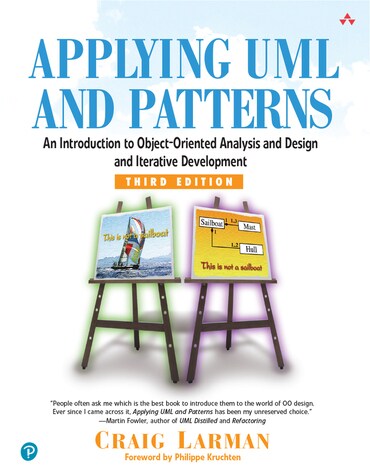
Applying UML and Patterns: An Introduction to Object-Oriented Analysis and Design and Iterative Development, 3rd edition
Published by Pearson (October 20, 2004) © 2005
Craig Larman
Switch content of the page by the Role togglethe content would be changed according to the role
Title overview
Craig Larman again delivers a clear path for students to learn object-oriented analysis and design through his clear and precise writing style. Larman teaches newcomers to OOA/D learn how to “think in objects” by presenting three iterations of a single, cohesive case study, incrementally introducing the requirements and OOA/D activities, principles, and patterns that are most critical to success.
This third edition again delivers a clear path for students and professionals to learn and apply object-oriented analysis and design.
- The first two editions of this book have achieved gross sales of more than 60,000 units through the domestic retail channel
- Timely and up-to-date; compliant with UML 2.0 and the latest trends in design patterns and object-oriented analysis and design
- More gold from one of the leading names in software engineering: Craig Larman!
- Instructor resources are available from the author's website, www.craiglarman.com.
- New features include: MDA, service-oriented architectures and agile modeling.
- More coverage on database, user interface modeling, XP, Scrum and the Implementation Model in the Unified Process.
Table of contents
- I. INTRODUCTION.
- 1. Object-Oriented Analysis and Design.
- 2. Iterative, Evolutionary, and Agile.
- 3. Case Studies.
- II. INCEPTION
- 4. Inception is Not the Requirements Phase
- 5. Evolutionary Requirements.
- 6. Use Cases
- 7. Other Requirements.
- III. ELABORATION ITERATION 1-BASICS
- 8. Iteration 1-Basics
- 9. Domain Models
- 10. System Sequence Diagrams
- 11. Operation Contracts
- 12. Requirements to Design-Iteratively
- 13. Logical Architecture and UML Package Diagrams
- 14. On to Object Design
- 15. UML Interaction Diagrams
- 16. UML Class Diagrams
- 17. GRASP: Designing Objects with Responsibilities
- 18. Object Design Examples with GRASP.
- 19. Designing for Visibility
- 20. Mapping Designs to Code
- 21. Test-Driven Development and Refactoring
- IV. ELABORATION ITERATION 2-MORE PATTERNS
- 22. UML Tools and UML as Blueprint
- 3. Quick Analysis Update.
- 24. Iteration 2-More Patterns.
- 25. GRASP: More Objects with Responsibilities.
- 26. Applying GoF Design Patterns.
- V. ELABORATION ITERATION 3-INTERMEDIATE TOPICS.
- 27. Iteration 3-Intermediate Topics.
- 28. UML Activity Diagrams and Modeling.
- 29. UML State Machine Diagrams and Modeling.
- 30. Relating Use Cases.
- 31. More SSDs and Contracts.
- 32. Domain Model Refinement.
- 33. Architectural Analysis.
- 34. Logical Architecture Refinement.
- 35. More Object Design with GoF Patterns.
- 36. Package Design.
- 37. UML Deployment and Component Diagrams.
- 38. Designing a Persistence Framework with Patterns.
- 39. Documenting Architecture: UML & the N+1 View Model.
- VI. SPECIAL TOPICS
- 40. More on Iterative Development and Agile Project Management.
- Recommended Resources.
- Bibliography.
- Glossary.
- Index.
Author bios
Craig Larman serves as chief scientist at Valtech, a leading technology consultancy with offices throughout the United States, Europe, and Asia. He is known throughout the worldwide software community as an expert and coach in OOA/D and design patterns, agile/iterative methods, an agile approach to the Unified Process (UP), and modeling with the UML. He holds a B.S. and M.S. in computer science from Simon Fraser University in Vancouver, British Columbia.
